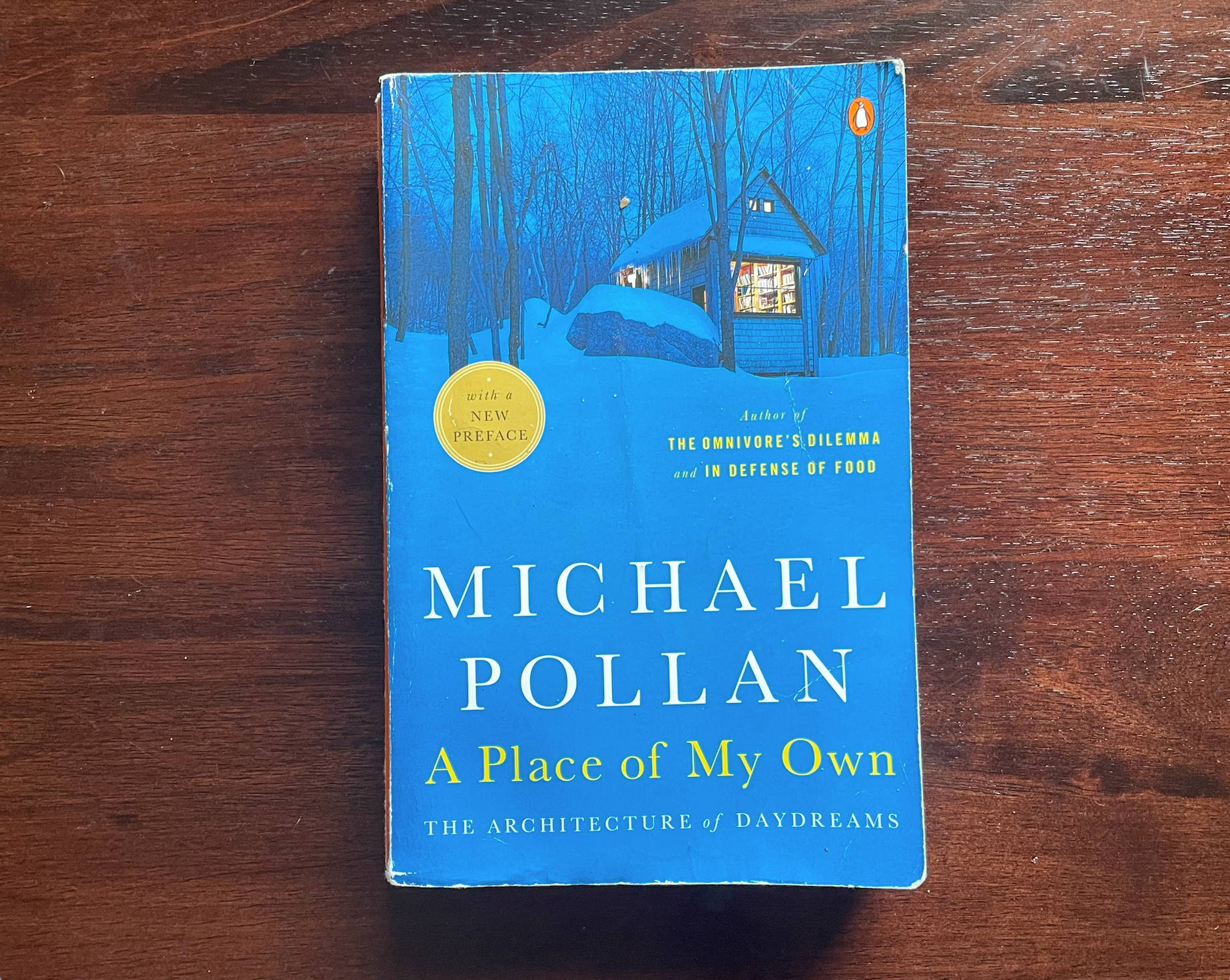There’s so much packed into A Place of My Own that I really don’t think I’ll be able to do it justice in this book review. It’s simply genius. The idea of it, its structure, and most of all, the writing, is honestly nothing like I’ve read before. Nevertheless, here’s my attempt at reviewing the brilliant A Place of My Own: The Architecture of Daydreams by Michael Pollan.
A Brief Synopsis of A Place of My Own
A Place of My Own is a non-fiction book about a man (the author, Michael Pollan) who decides to build a small house—a room of sorts—on his property near his main house. From the onset, readers will recognize that the small house is far from meaningless to Pollan.
The house is mainly for him to “write and think and daydream” (p, xv), a refuge where he can not simply escape, but enter, into a world that’s completely his own. It’s the importance Pollan places on creating this type of space that makes the book as compelling as it is.
“I began to see how there might be a connection between the kind of mental life I hoped such a place might house and the kind of work I’d have to learn in order to build it, a connection hinted at in words such as independence, individual, pragmatic, self-made. To build a house in the first person, a place as much one’s own as a second skin, would require an exploration of self and place—and work itself—that simply could not be delegated to somebody else. The meaning of such a place was in its making.”
— A Place of My Own (Pollan, 1997, p. 24)
In each of the chapters, Pollan takes readers on his journey of constructing the site, from foundation to finish. Though he hires an architect to design the space, he decides to build it on his own. It’s important to note that Pollan is by no means the handy-type, telling us early on that “To know me even slightly is to know how ill-equipped I was to undertake such an enterprise, and how completely out of character it would be” (p. 4). Yet, as removed as he is with the physical world (Pollan is a man of words), he goes on to build one hell-of-a space.
The book is also an incredibly well-research philosophical treatise of space and architecture. Pollan rigorously traces the ideas of everyone from Henry Thoreau to Le Corbusier to describe how he’s approaching a place of his own. Suffice to say, readers are in for an intellectual journey that—while somewhat roundabout at times—always gets backs to the topic at hand, whether that’s the ceremonial meanings of roofs or the usage of copious wood types.
Brilliant Connections
One of the things I love most about A Place of My Own are the brilliant connections Pollan makes between seemingly disparate topics. In his characteristically engaging and skillful writing, he connects sacrificial rituals and humans’ relationship with wood, as one example.
It’s clear that Pollan is remarkably intelligent and well-read. In another instance, he talks about the Renaissance period and it being the first time ever that people sought private space. He then makes the argument that because of this, literary culture changed: people began to write more about themselves through memoirs, diaries, and essays.
The fact that these connections and arguments are so crisp is what will make readers fall in love with the book. He rounds them out and uses examples from ancient texts and everyday interactions to get the reader to see the point he’s trying to make.
Relationship with Place and Space
I forgot where I came across A Place of My Own, but I think the reason I bought it in the first place was because it was about a cultivated space of solitude. I’ve been thinking a lot about this throughout the last year. Mainly how much I need that space to think and read and explore my mind.
I got exactly this during my time in Buenos Aires and saw how much of a difference it made in my well-being. To say that I was simply happier doesn’t quite cut it. I was at peace and in tune with myself. I think having such a place—shoutout to my AirBnb in Palermo Soho!—was one of the main reasons for this.
“How important to me was the company of a tree, or the reflection of water? Just how available to the gaze of others—on the road, in the house—did I wish the face of my building to be? Some sites I considered offered what seemed like the geographical correlative of shyness, others self-assertion. It was as though the landscape were asking me to declare myself, to say this place, and not that one, suited me, in some sense ‘was’ me”
— A Place of My Own (Pollan, 1997, p. 37)
The title of this book says it all—Pollan is deeply searching for, needs almost, this type of place. He writes that an office in his actual house won’t cut it. He needs a place that is specifically designed for him and his mind. This is a privileged take, for sure. But I think it’s something we all should consider.
Imagine if we all had a place of our own, one designated to be alone with our thoughts (and books). I can’t help but think we’d be much more present in our interactions because of it.
A Place of My Own Defies Genre
One thing many readers might like about the book is just how many different genres it can fall into. Bird by Bird is definitely a close second, but A Place of My Own truly stands out as the most genre-defying book I’ve read.
It’s part architectural history, part how-to manual, part memoir, and so much more. Still, it’s not just genre, but also how the book itself is written. It’s staggering how Pollan was able to merge these different types of literary flares and flavors to create this piece of art. And, he makes it look SO easy!
“…some readers (and even some reviewers) have approached A Place of My Own as a kind of how-to book that would tell them how to build there own cabin in the woods. I worry about these readers—and even more about their buildings. For while it is true that the book is organized, step-by-step, around the first-this-then-that syntax of designing and building a house, with chapters of Drawing, Foundations, Framing, Windows, and Finishing, A Place of My Own was never intended as a recipe or construction manual…A Place of My Own is not so much a how-to-do-it than a how-to-think-about-it kind of book”
— A Place of My Own (Pollan, 1997, p. xi)
Sometimes his writing is reflective, resembling a personal essay. At other points in the book, his writing mirrors a historical account of architecture from the Renaissance period to that of postmodernism. He’ll also write at great length yet engagingly about unremarkable topics like windows and book shelves. That said, there are times when he can go a little bit too in-depth, especially in his use of technical construction and building language. Yet most times when I started to feel this, the writing would seamlessly come back to the house and his connection with it.
Pollan’s Writing
I’d be remiss not to have a separate section dedicated to Michael Pollan’s writing. He is incredibly talented and thoughtful in his prose, and quite poetic at times. Here is talking about wood:
Now I knew fir, how the rub of oil elicits its fine salmon hue, and how the small, tight knots in an ordinary two-by-four will fluster the calm sweep of its grain. White pine blushes faintly pink, swirling here and there with nuttier streaks of heartwood, and as the permanent wetting of the oil brought forward the sweeping grain and figuration of my ash, I could make out beneath the desk’s finish what looked like a half-dozen baseball bats flattened out in a kind of Mercator projection.
Pollan, 1997, p. 293
I found myself enamored with this writing throughout—rereading passages several times over in complete awe at how good he is with words. In fact, early on, on page 4, I wrote in the margins: “this guy can write!” And boy, can he!
For this reason alone, I recommend A Place of My Own. Even if you have no interest in architecture or the significance of space, you’ll likely find yourself appreciate of Pollan’s writing. As someone who strives to one day craft words with half the precision and elegance as Pollan, I surely was.
‘Till Next, Time Travel Friends!
Rating: 8.5/10







